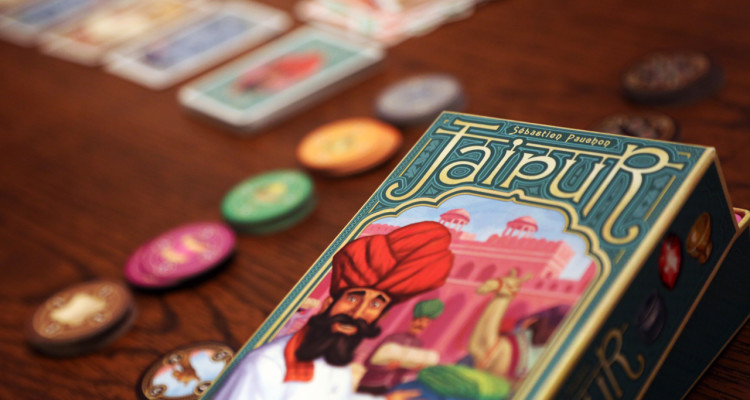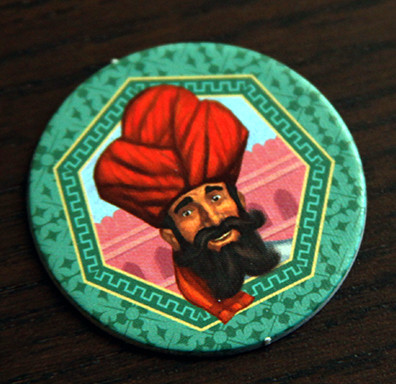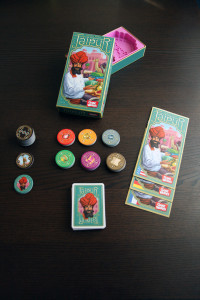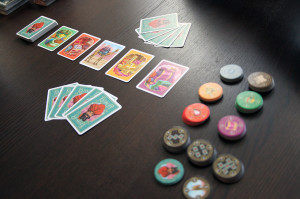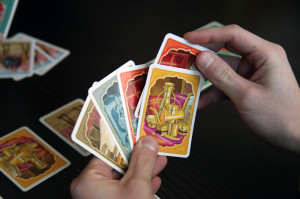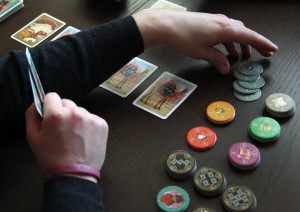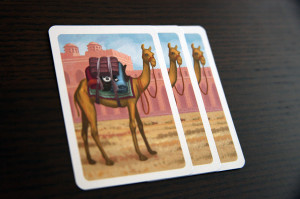INTRODUCTION
Welcome to Jaipur, capital of Rajasthan, the land of kings. In Jaipur, you assume the role of a successful trader vying for the privilege of being invited to the Maharaja’s Court as his exclusive personal trader. You will accomplish this by amassing the greatest riches using your lavish wares to out buy, sell and trade your equally skilled competition. Once your invite is secure, the women, all closely resembling Aishwarya Rai, will flock to you like the salmon of Capistrano. Ok, so that’s more what I try to think of when playing this game. Reality is you’ll be handed a cardboard Seal token showcasing a dude with an epic beard. The first player to collect two of these Seals of Excellence (in Beard Growing) receives the coveted invite; ergo winning the game.
Did I mention that you also moonlight as a camel herder?
DESIGN
Jaipur, designed by Sébastien Pauchon, is a card game of set collection and hand management for two players that plays in about 30 minutes. The game as a whole is entirely language independent with only numbers, symbols and colors used on the components. The rulebook comes in 3 languages (German, French and English) and is extremely well put together with graphic examples for ease of use.
Jaipur comes in a succinct box with a slightly thematic insert which perfectly holds the 55 cards and 60 tokens you need to play. The cards themselves are made of quality stock and have held up well through numerous plays. This proves to be crucial as sleeved cards do not fit exceptionally well in the provided insert. The tokens are well sized and crafted from the finest cardboard in all the land. While the overall art direction closely resembles bordered clip art from Microsoft Office 1995, it may well be one of the only links Jaipur has to its theme. The mechanics definitely carry this title.
GAMEPLAY
The game closely resembles Rummy with its core mechanics of acquiring cards, building sets and scoring points but with enough variation that they could change the name to Jaipur. The deck is comprised of six (6) different types of goods and the lovable camels. Goods range from the common leather, spice and cloth to the expensive silver, gold and diamonds. The expensive goods are worth more points when selling however, players will find less of them in the deck (only 6 each, 18 total) to trade.
Setup
Setup for Jaipur is relatively painless. Sort and stack the goods tokens in descending order of value by good type (i.e. diamonds 7, 7, 5, 5, 5) and randomly stack the bonus tokens, value face down, by bonus type (i.e. 3, 4, or 5 cards sold). The camel token and Seals of Excellence (in Beard Growing) can be placed off to the side for now. Next, remove three (3) camel cards from the deck and place them in the center of the play area. This area forms the market accessible by both players. The remaining cards are shuffled, five (5) cards are dealt to each player and the deck is sat next to the market. After dealing each player their cards take the top two cards off the deck and place them in the market next to the three (3) starting camels. Voila! Your market is now ready – and you wasted no more than 5 minutes of your life setting it up.
Game Turn
A game turn isn’t exactly a brain burner. You have two options, to either take cards or sell cards. Mind-bottling, I know. There are a few caveats to each though. A player choosing to take cards must do ONE (1) of the following:
-
Take a single good;
-
Take multiple goods; or
Taking a single good is thematically the equivalent of buying a good. The player may select one good type currently shown in the market and place it in their hand. The market is then replenished by the top card of the deck. Taking multiple goods requires a bit of hand management on the player’s part as a minimum of two cards must be taken and an equal amount returned to the market. These cards can comprise goods (differing from the ones taken in the market), camels or a mixture of both.
Finally, a player may take ALL of the camels in the market. The market spaces vacated by the camels are replenished from the top of the goods deck. Each player may never exceed a maximum hand size of seven (7) cards at the end of their turn. (Note: Camels in your herd do not count towards this maximum)
The other action a player may take is to sell his or her goods. For this a player selects a good type in his or her hand and discards as many cards of that type. For each good card discarded, the player takes a corresponding goods token from the top of the stack. With the goods being stacked in descending order of value it benefits the player to be the first to sell goods of that type for greater points. If three (3), four (4) or five (5) goods of the same type are cashed in, the player also takes a bonus token from the pile matching the number of goods sold. The only restriction with selling goods is that the 3 most expensive goods (diamonds, gold, and silver) must be sold in sets of 2 or more. So while you may only trade in that one (1) leather to grab a quick 4, you must wait to have two (2) or more of the expensive goods before selling.
Round play continues until three (3) of the goods stacks are gone or there are no more cards left in the deck to replenish the market. This triggers the end of the round and players will count up the total value of their goods sold and any bonus tokens received. The player with the most camels remaining in their herd also receives the five (5) point camel bonus token (Note: if tied, neither player is awarded the token). The player at the end of the round with the most points is awarded a Seal of Excellence (in Beard Growing). First player to receive two (2) seals wins the game.
OVERALL EXPERIENCE
While this game does not require much more than a functioning brain and at least one hand to play, it does offer a decent amount of choices for the players to make. The timing of buying, exchanging and selling goods is crucial to each player’s success. The earlier a player can acquire a set, the more points he or she can gain due to the tokens being stacked in descending order of value; the first token of each good being worth the most points. Simple economics, really. Wait too long on that leather and you may be left with a hand of low value cards now that demand has gone down. Trying to collect too much leather may net you a large market share in leather (and possible a bonus token) but you may be missing out on acquiring the higher valued expensive goods.
Camels also play into the strategy and become a valuable form of currency for trading goods. Being able to trade your camels to the market is especially beneficial when your hand size is nearing its limit; building for a large set or even hoarding cards you know the other player is searching for. A market predominantly made up of camels forces the players to decide whether or not taking all of the camels and opening up the market to new goods would be detrimental to their strategy. Again, timing is everything and you may want to wait for an opponent to have a full hand before doing this in order to force a bit of hand management on them.
Finding that happy balance between hand and herd as well as knowing when to sell is the key to becoming the Maharaja’s personal trader.
LEAGUE RULING
naD
Jaipur is a great set collection card game for 2 players and accessible to all age ranges. For these reasons alone, I am a huge fan of the game. I find myself playing it most while killing time with my wife or with a friend/sibling waiting for others to show up for game night. The simple set up and easily explained rules allow players to have it on the table and ready to play within five (5) minutes. The choices within the game, while few, use enough brain power to keep players casually engaged during their reprieve from the other brain burners currently on offer in their collection. I have seen rumblings about the lack of theme. Granted the artwork isn’t anything to write home about but for a 20-30 minute filler in the $25 price range I personally find it to be sufficient. If you are looking for a quick and easy filler with set collection and a bit of hand management sprinkled in, I think you’ll find Jaipur more than scratches your itch (or wherever else you’d like it to scratch).
Buns
Jaipur offers a great two-player experience that is easy to quickly set-up and play. My biggest criticism is that the game can often be a bit swingy due to the random distribution of goods within the deck. There is some strategic play to mitigate luck, but usually it’s difficult to come back from a deficit. The great thing about Jaipur is that you can easily fit in multiple best-of-three matches in the same time it would take to play a single game of something else. This makes blowout rounds less painful because you haven’t lost much time and it was likely still very fun. If you find yourself gaming for two and need a lightweight game to fill a half hour, Jaipur is an excellent choice.
Kelly B!
This is a great game. I love that it doesn’t take hours to get through setting it up and playing and that it can easily be taught to new players. Plus, I’m not terrible at it and a game that you don’t always lose at is always more fun than a game you suck at. Finally, herding camels is always a great time.
Pros: Fast; simple; camels; collecting mustachioed man chips
Cons: difficult to come back from deficit if timing of precious items isn’t in your favor
Ben
Jaipur is a small, fast game, and it is pretty awesome. It’s a game that is great for several reasons. It’s a filler game because it can be played rather quickly and takes a whole 60 seconds to set up, 90 if you have trouble stacking tokens in numerical order. It’s also good after a brain burner. I tend to play this game one turn at a time, picking the best options available in the moment. Since the cards available are random, I don’t try to plan too far ahead. Usually when I do try to stock up on an item they will only start showing up when it’s not my turn, so I avoid it. Overall, this is a worthy game to have in your collection that I would probably make a must-have if the price came down to around $15.
Biff
I hate playing this game with my girlfriend. She ruins every game I love.
IMAGE GALLERY

